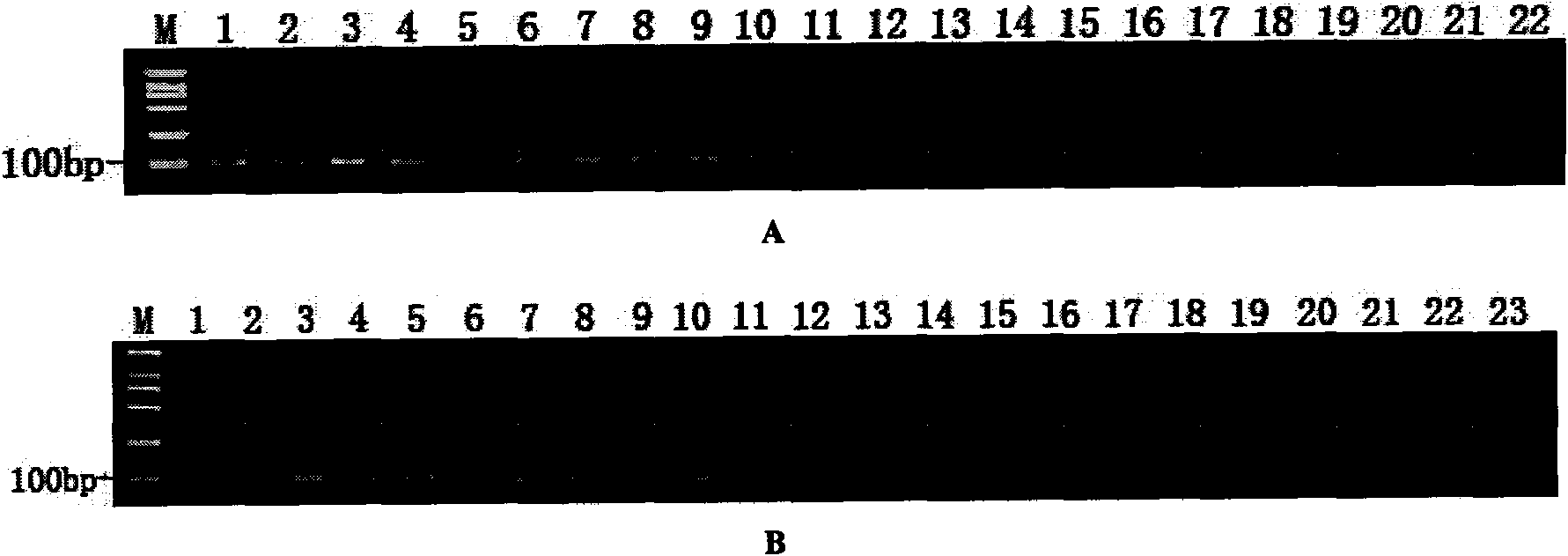Padlock probe for detecting Xanthomonas oryzae pv. oryzae and anthomonas oryzae pv.oryzicola and multiple detection method
A technology for rice bacterial blight and p-x.o.oc, which is applied in the biological field, can solve problems such as difficulty in realizing multiple detection, and achieve the effects of avoiding false positives, strong specificity and high sensitivity
- Summary
- Abstract
- Description
- Claims
- Application Information
AI Technical Summary
Problems solved by technology
Method used
Image
Examples
Embodiment 1
[0050] Example 1: A multiple detection method using padlock probes combined with Macroaary technology for simultaneous detection of Xanthomonas oryzae and bacterial streak.
[0051] The padlock probe sequence used to detect Xanthomonas oryzae:
[0052] P-x.o.o: 5'-GGAGCTATATGCCGTGCTGTGTGGAGTAP I P 2 * GAATCGCCTACAATTCTGTC CCCCAAGTTGCCTC-3' is used to detect the padlock probe sequence of rice bacterial leaf spot:
[0053] P-x.o.oc: 5'-CCACACAACACGGCATATCGCTCCAAGGP I P 2 * GCGGCATACGTTCGTCAAAT GGTGGCTTTGTACC-3'
[0054] (1) Ligation reaction solution includes: 20mM Tris-HCL, pH 9.0, 25mM KCH 3 COO, 10mM Mg (CH 3 COO) 2 , 10mM DTT, 1mM NAD, 0.1% Triton X-100, 2.4U Taq DNA ligase, 1μl template to be tested, probe P-x.o.oc, P-x.o.oc each 100pm. The ligation reaction program is: pre-denaturation at 95°C for 5 minutes; then cycle, denaturation at 95°C for 30 seconds, ligation at 65°C for 5 minutes, and a total of 20 cycles of reaction; then inactivation at 95°C for 15 m...
example 1
[0057] Example 1 detects Xanthomonas oryzae and bacterial streak bacterium from the rice of Anhui morbidity:
[0058] The above-mentioned padlock detection probes of rice bacterial blight and bacterial streak and their multiple detection methods are used to detect the diseased rice in Anhui, and the methods include:
[0059] 1) Extract DNA from the roots (R), stems (S) and leaves (L) of rice samples infected in Anhui as detection templates, and the extraction method refers to Mc McCouch S R (1988).
[0060] 2) Referring to the above technical scheme, use padlock detection probes P-xoo and P-xooc combined with Macroaary to detect samples. See the test results Figure 5 . The results showed that 19 of the 60 rice samples with the disease in Anhui were detected to have bacterial blight, and 17 to have bacterial streak. It is proved that the above-mentioned technical scheme can be applied to the actual detection of rice bacterial blight and bacterial streak.
PUM
 Login to View More
Login to View More Abstract
Description
Claims
Application Information
 Login to View More
Login to View More - R&D
- Intellectual Property
- Life Sciences
- Materials
- Tech Scout
- Unparalleled Data Quality
- Higher Quality Content
- 60% Fewer Hallucinations
Browse by: Latest US Patents, China's latest patents, Technical Efficacy Thesaurus, Application Domain, Technology Topic, Popular Technical Reports.
© 2025 PatSnap. All rights reserved.Legal|Privacy policy|Modern Slavery Act Transparency Statement|Sitemap|About US| Contact US: help@patsnap.com



